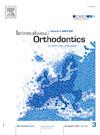Diagnostic accuracy of mandibular dental maturation stages for determination of growth spurt compared to the cervical vertebral maturation method: A systematic review and meta-analysis
IF 1.9
Q2 DENTISTRY, ORAL SURGERY & MEDICINE
引用次数: 0
Abstract
Objectives
To assess the diagnostic accuracy for dental maturation stages of various mandibular teeth in detecting the growth spurt compared to the cervical vertebral maturation (CVM) method.
Methods
Eligibility criteria: observational studies assessing dental calcification stages of mandibular teeth for predicting pubertal CVM stages (CS3 and CS4), reporting cross-tabulation and involving healthy growing patients. Information sources: an unrestricted literature search of five databases was conducted up to February 2, 2024. Risk of bias: the quality assessment of the studies was conducted using the Joanna Briggs Institute (JBI). Synthesis of results: random-effects meta-analyses using sensitivity, specificity, and diagnostic odds ratio and their 95% confidence intervals (CIs) were performed, followed by subgroup analyses.
Results
Included studies: eighteen observational studies involving 3965 participants (38.91% male) were included. Synthesis of results: the diagnostic odds ratios (DORs) of tooth calcification stages were low, indicating that tooth mineralization provides no useful diagnostic information. Only in stage G of the second molar (DOR: 1.47 [95% CI: 0.49–4.41]) and stage C of the third molar (DOR: 1.7 [95% CI: 0.1–28.9]), the values were slightly higher than one, but they were statistically insignificant.
Discussion
Limitations of evidence: most of the studies published on this subject lack cross-tabulation, which prevents the calculation of diagnostic parameters and limits generalizability. The use of CVM as a gold standard can be suboptimal due to several limitations, including inferior inter-observer reliability, unreliability as an indicator of the pubertal growth peak, and retention of pubertal stages in one-fifth of individuals for over 20 years.
Interpretation
Tooth calcification stages are not a reliable indicator for predicting the pubertal growth spurt.
Registration
PROSPERO (CRD420250654430).
与颈椎成熟法相比,下颌牙成熟阶段测定生长突升的诊断准确性:系统回顾和荟萃分析
目的比较颈椎成熟法(CVM)对下颌不同牙发育阶段生长突增的诊断准确性。方法入选标准:评估下颌牙钙化阶段以预测青春期CVM阶段(CS3和CS4)的观察性研究,交叉表列报告并纳入健康生长患者。资料来源:截至2024年2月2日,对5个数据库进行无限制文献检索。偏倚风险:研究的质量评估由乔安娜布里格斯研究所(JBI)进行。结果综合:采用敏感性、特异性、诊断优势比及其95%置信区间(ci)进行随机效应荟萃分析,然后进行亚组分析。结果纳入研究:纳入18项观察性研究,涉及3965名受试者(38.91%为男性)。综合结果:牙齿钙化阶段的诊断优势比(DORs)较低,表明牙齿矿化不能提供有用的诊断信息。只有第二磨牙G期(DOR: 1.47 [95% CI: 0.49-4.41])和第三磨牙C期(DOR: 1.7 [95% CI: 0.1-28.9])的数值略高于1,但差异无统计学意义。证据的局限性:大多数发表的关于这一主题的研究缺乏交叉制表,这阻碍了诊断参数的计算并限制了通用性。使用CVM作为金标准可能是不理想的,因为有几个限制,包括较差的观察者间信度,作为青春期生长高峰指标的不可靠性,以及五分之一的个体在20年以上的时间里保持青春期阶段。牙齿钙化阶段并不是预测青春期生长高峰的可靠指标。RegistrationPROSPERO (CRD420250654430)。
本文章由计算机程序翻译,如有差异,请以英文原文为准。
求助全文
约1分钟内获得全文
求助全文
来源期刊

International Orthodontics
DENTISTRY, ORAL SURGERY & MEDICINE-
CiteScore
2.50
自引率
13.30%
发文量
71
审稿时长
26 days
期刊介绍:
Une revue de référence dans le domaine de orthodontie et des disciplines frontières Your reference in dentofacial orthopedics International Orthodontics adresse aux orthodontistes, aux dentistes, aux stomatologistes, aux chirurgiens maxillo-faciaux et aux plasticiens de la face, ainsi quà leurs assistant(e)s. International Orthodontics is addressed to orthodontists, dentists, stomatologists, maxillofacial surgeons and facial plastic surgeons, as well as their assistants.
 求助内容:
求助内容: 应助结果提醒方式:
应助结果提醒方式:


